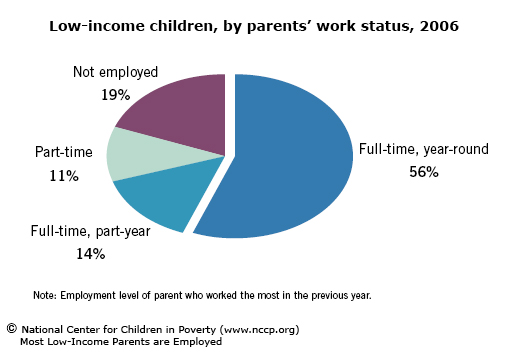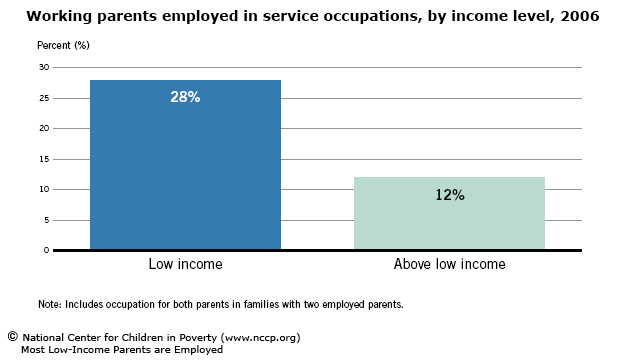Despite low levels of unemployment, average household income has declined since 2000. The number of children living in low-income families has continued to rise. Programs that provide supports for low-income, working parents can increase income and child well-being.
The majority of children in low-income families have parents who are employed full-time and year-round.

- 56% of children in low-income families – 16.0 million – have at least one parent who works full-time and year-round.
- 25% of children in low-income families – 7.0 million – have at least one parent who works part-time, or full-time, part-year.
- 19% of children in low-income families – 5.5 million – do not have an employed parent.
Many low-income parents who work part-year or part-time are unable to find full-time, year round employment.
- The majority (57%) of low-income parents working full-time for only part of the year reported they could not find year-round work.
- 33% of low-income parents working part-time reported they did so because they could not find full-time work.
More than two thirds of low-income parents who did not work at all last year were either disabled or taking care of their families.
- Forty-two percent of low-income parents with no employment reported they were not working because they were taking care of their families.
- An additional 35% of low-income parents with no employment reported they were not working because they had an illness or disability that kept them from working.
Low-income parents who work are more likely to be employed in service occupations.

Workers in service occupations are not only likely to have lower earnings and fewer opportunities for full-time employment, but they are also less likely to receive benefits such as health insurance, paid vacation, or holidays.
Policy Implications
Public policy can support low-income working parents – and therefore their children – by providing relief from work-related expenses (such as child care and transportation), increasing income, and strengthening the safety net for temporary unemployment spells.
Policy strategies include:
- Increase wages. Almost one in three employed, low-income parents works in the service industry – jobs that often pay the minimum wage. Research shows that a single parent with two children typically needs to earn $16.50 an hour full-time – or about $34,000 a year – to provide for the family’s basic needs. Yet the highest state minimum wage is under $8 an hour, and the federal minimum wage is only $5.85, even with the recent increase. In the absence of higher wages, the federal Earned Income Tax Credit (EITC) increases the value of low-wage work and lifts millions of people out of poverty every year.
- Help low-income working parents with child care costs. Despite the expansion of child care subsidies in the 1990s, coverage rates remain low, especially for families with incomes above the poverty level. To maintain employment, working parents need affordable, stable child care arrangements for their children.
- Maintain support for Social Security and Supplemental Security Income (SSI). Providing insurance for families who experience the disability or death of a primary breadwinner can provide a safety net for low-income parents and their children. In the Social Security program alone, over 5 million children benefit as dependents of individuals who have died or become disabled, or as members of households that rely on Social Security. For those who do not qualify for Social Security, SSI provides means-tested assistance for disabled adults and children.
Endnotes
This fact sheet is part of the National Center for Children in Poverty’s demographic fact sheet series and is updated annually. This is the 2007 edition. Estimates were prepared by Ayana Douglas-Hall and Michelle Chau based on the U.S. Current Population Survey, Annual Social and Economic Supplement, March 2007. Estimates include children living in households with at least one parent and most children living apart from both parents (for example, children being raised by grandparents). Children living independently, living with a spouse, or in group quarters are excluded from these data. Children ages 14 and under living with only unrelated adults were not included because data on their income status were not available. Among children who do not live with at least one parent, parental characteristics are those of the householder and/or the householder’s spouse.
1. U.S. Bureau of Labor Statistics. (2006). Table 1: Employment status of the civilian, noninstitutional population, 1940 to date. Accessed September 5, 2007.
2. DeNavas-Walt, C.; Proctor, B.; & Lee, C. (2007). Income, poverty, and health insurance coverage in the United States: 2006 (Current Population Reports, P60-233). Washington DC: U.S. Census Bureau. Household income is measured as the median household income, adjusted for inflation.
3. Parental employment is the employment level of the parent in the household who maintained the highest level of employment in the previous year. Full-time/year-round is defined as working at least 50 weeks and 35 hours per week for the majority of those weeks. Part-time is defined as working fewer than 50 weeks and working fulltime in the majority of weeks worked.
4. Low income is defined as twice the federal poverty level, or $41,300 for a family of four (2007).
5. Parents experiencing slack work (i.e., their company is not providing full-time work, but they maintain a formal attachment) are included in this statistic.
6. Nelson, J. (1994). Work and benefits: The multiple problems of service sector employment. Social Problems, 41(2), pp. 240-256.
7. The policy strategies enumerated below are drawn from Cauthen, N. K. & Lu, H. (2003). Employment alone is not enough for America’s low-income children and families (Living at the Edge Research Brief 1). New York, NY: National Center for Children in Poverty, Columbia University Mailman School of Public Health.
8. See National Center for Children in Poverty. Minimum wage standards.
9. Cauthen, N. K. (2005). Why Social Security matters to children and families: What every policymaker should know. New York, NY: National Center for Children in Poverty, Columbia University Mailman School of Public Health.
